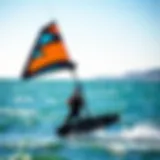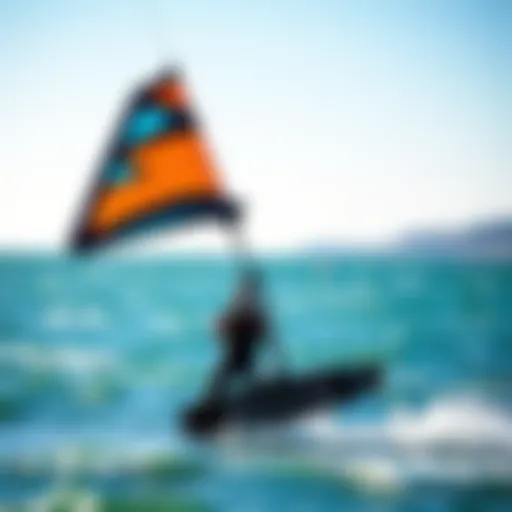Mastering Carving in Kiteboarding: Techniques and Destinations
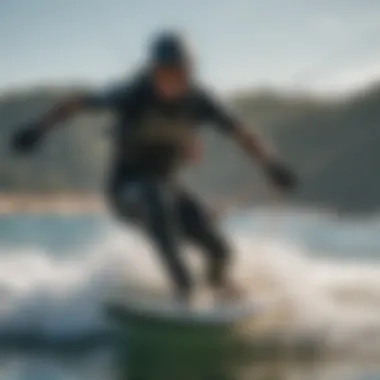

Intro
Carving in kiteboarding isn’t just a trick; it’s a dance between rider, kite, and water. Think of it as an art form, where each movement and decision becomes part of a fluid symphony. Understanding the nuances of carving can elevate your kiteboarding game, adding style and control to every ride. When the wind is right and the conditions are sweet, carving allows you to harness the power of the kite, transforming what could be a simple ride into an exhilarating experience.
In this article, we’ll explore every corner of carving — from selecting the right gear to essential techniques, and we’ll identify the best spots globally that cater to this skill. Additionally, we’ll dive into the ever-important aspects of safety and environmental consciousness as they relate to this thrilling sport. Whether you are just starting out or you’re a seasoned pro looking to refine those moves, this guide aims to equip you with the knowledge needed to enjoy kiteboarding to the fullest.
Gear Selection
Choosing the right gear is foundational for effective carving. Here’s a closer look at some critical components that can enhance both performance and enjoyment.
Types of Kites
When selecting a kite, you might feel like a kid in a candy store, thanks to the variety of options available. The main types suitable for carving include:
- C-Kites: These are renowned for their massive power and responsiveness. If you’re looking to carve sharp angles, a C-kite may be your best bet.
- Bow Kites: With a larger wind range, bow kites are forgiving and versatile, making them great for those still finding their rhythm.
- Delta Kites: Known for their stability in diverse conditions, delta kites encourage smooth transitions and are user-friendly for novice riders.
Consider your skill level and intended riding style while selecting your kite. A kite too powerful for your experience can turn enjoyable sessions into stressful encounters.
Choosing the Right Board
A well-suited board can mean the difference betwen a good ride and a great one. When picking a board, it’s important to think about:
- Size: Shorter boards allow for sharper turns and quicker response, while longer boards provide stability and glide. Choose based on your weight and riding style.
- Type: Freeride boards generally offer flexibility, while freestyle boards cater to tricks and jumps. For carving, a directional board is often favored because of its stability and maneuverability.
- Material: Boards made from lightweight materials enhance speed. However, durability is also a concern, especially in terrain or conditions that could cause wear.
Skill Development
The journey towards mastering carving involves practice and the right techniques. Embrace each step to progress effectively.
Essential Techniques
- Weight Distribution: Shift your weight subtly. Lean back into your heels when carving heelside and forward on your toes for toeside turns. Finding the right balance can make even the trickiest maneuvers achievable.
- Kite Control: Keep your kite low and steady during a carve to maintain power. Many riders often forget this crucial aspect, leading to a loss of speed.
- Edge Control: Use the board’s edges deeply into the water allows you to cut through the waves, giving you that exhilarating feeling of carving across the surface.
Progression Tips
To keep improving your carving skills, consider the following:
- Practice Regularly: The more time you spend on the water, the better. Consider dedicating sessions to just carving.
- Join a Community: Find peers who share similar interests. An extra set of eyes brings valuable feedback.
- Video Analysis: Record your sessions and analyze them. It’s easier to spot errors or areas for improvement when you can view them.
"The water is my canvas, and each carve tells a story that only I can write."
With the right gear and techniques in hand, you're primed to carve out your own path—or shall we say, your own wave?
Understanding Carving in Kiteboarding
Carving in kiteboarding is not merely a technique but a distinct art that can significantly enhance both the rider’s experience and performance on the water. It involves smooth turns and transitions that allow the kiteboarder to harness the power of the wind and the water to glide gracefully across the surface. Mastering this skill can transform a novice ride into a more vibrant and dynamic experience. In kiteboarding, carving serves to improve speed control, allow for better directional changes, and build confidence among riders, especially during challenging maneuvers.
Definition and Importance
Carving is specifically defined as the act of turning the board while maintaining a smooth edge against the water, which results in a fluid motion. The importance of carving lies in its function; it helps riders navigate the water with precision while also enabling them to perform tricks and jumps effectively. Beyond the physical benefits, carving also contributes to the aesthetic aspect of kiteboarding. A rider who carves well appears to be in perfect sync with the elements, moving seamlessly as if part of the ocean itself.
The ability to carve effectively can help to stretch a rider’s limits. When working on carving skills , one can feel an exhilarating sense of control that personalizes the overall experience of the sport. For those looking to join competitions, advanced carving techniques can distinguish experienced kiteboarders from the rest, making it an essential skill set to develop.
Physics of Carving
Understanding the physics behind carving can aid riders in mastering this crucial skill. The core principle involves the interaction between the kite, the wind, and the rider’s body mechanics. When a kiteboarder adjusts their stance, they manipulate their body weight to generate the necessary force to carve efficiently.
The forces at play include:
- Lift: The lift generated by the kite allows the rider to maintain altitude while carving. An adjusted angle of the kite can enhance lift during a turn.
- Drag: This is the resistance faced by the board when gliding across the water's surface. Effective carving minimizes drag through a smooth and calculated edge engagement.
- Weight Distribution: Shifting weight from one side of the board to the other directly influences the carving radius. A forward lean will quicken a turn while maintaining stability.
An understanding of these concepts contributes to a rider’s ability to carve sharper turns and maintain speed. Knowledge of physics serves as a foundation for performance and can unlock further potential on the water. Thus, recognizing the importance of carving means embracing both the artistic and technical aspects of kiteboarding.
Necessary Skills for Effective Carving
Carving is not just a skillful move; it’s a crucial element that can make or break one's kiteboarding experience. The essence of carving lies in the ability to manipulate your body, board, and kite harmoniously to create smooth and controlled turns on the water. Without mastering these skills, riders may find themselves struggling to maintain speed or balance, leading to frustration and potential safety hazards. For those serious about progressing in kiteboarding, honing carving techniques is essential.
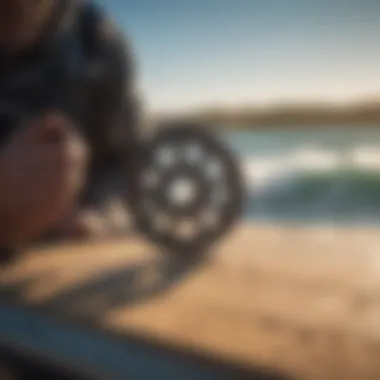

Body Position and Weight Distribution
The foundation of effective carving is body position. Proper stance allows you to harness maximum control over your board as you navigate through various conditions. Start with your feet shoulder-width apart, knees slightly bent, and your center of gravity focused low. As you initiate a carve, lean into the edge of the board while keeping your upper body aligned with your direction of travel.
Weight distribution is just as critical. You’ll want to shift your weight carefully. For instance, in a downwind carve, lean back slightly to allow the board to glide smoothly through the water. Conversely, in an upwind carve, the weight should be more centered to slice through the waves effectively.
Key points to remember:
- Keep your knees bent and loose to absorb the waters' chop.
- Avoid locking your legs as it can result in instability.
- Focus your weight towards your toes or heels depending on the turn direction.
Board Control Techniques
Next up is having a firm grip on board control techniques. The right technique ensures that your board responds illogical sequence to your movements, providing freedom and flexibility on the water. Start by practicing gradual turns before you tackle sharper angles. In simpler terms, if you can’t steer clear of a little bump, how will you handle the big waves?
Your board should become an extension of your body. Engage your core; it aids in keeping balance and stabilizing your movements. Additionally, managing the kite's pull is vital. A consistent tension in your lines can improve your reaction time while carving. If tension varies too much, it might result in over-steering or losing control.
Remember to practice the following:
- Gradual transitions between toe-side and heel-side turns.
- Use your hips to pivot, allowing for more dynamic turns.
- Visualize the path you want to take before initiating the maneuver.
Timing and Coordination
Timing and coordination are the unsung heroes of carving. It’s not only about moving your body in sync with the kite; it’s about understanding the rhythm of the water too. Excessive thinking can lead to hesitation, throwing off your whole act. A seamless carving experience demands that you anticipate the moment to shift your weight just before executing a turn.
When carving, train yourself to feel when to pull on the kite while matching your body’s pivot. It’s a bit like dancing, where every step is dictated by the music. The better your timing, the smoother your transitions will become. Coordinating your movements lets you carve naturally, digging into your turns while maintaining speed.
Here are a few tips to refine your timing:
- Observe other riders and how they time their moves.
- Practice on consistent wind days to minimize variables.
- Experiment with different speeds and see how it affects your timing.
"Carving is a dance with the wind and water. To master it, you must become one with both."
Gear Essentials for Carving
When it comes to carving in kiteboarding, your gear is not just an accessory; it’s fundamental to the whole experience. The right equipment can mean the difference between mastering those sweet curves on the water and floundering like a fish out of water. This section breaks down what you need to focus on: the kite, the board, and the harness. Each element plays a crucial role in your carving performance.
Choosing the Right Kite
Finding the right kite is akin to picking the perfect partner for a dance—timing and compatibility are key. Kites come in various shapes and sizes, and each type can lend itself to different conditions and riding styles. A larger kite might provide more lift and is often preferred for light wind days, whereas a smaller kite is better in high winds, allowing for better control and responsiveness.
- Planform Shapes: The design of the kite alters its characteristics. For instance, a delta shape enhances stability and is easier for beginners to handle, while a C-shape offers more precise feedback for advanced riders.
- Material Considerations: Kites made from high-quality ripstop nylon or similar materials not only improve durability but also affect fly-ability.
- Bridle Configurations: Look for kites with adjustable bridle designs as they can be tuned for various conditions, providing versatility.
In essence, the right kite should match both your style and the conditions you typically encounter. Take time to do your homework and possibly test a few options before deciding.
Selecting the Appropriate Board
Your board is like your canvas. It directly influences how well you can execute carving maneuvers. Boards vary widely, and understanding what fits your style is crucial. Look for width, length, and flex—all play vital roles in how your board interacts with the water. A wider board will offer better stability and easier upwind performance, whereas a narrower board can give you sharper turns.
- Twin-Tip Boards: These are popular for freestyle riding and provide flexibility for both directions. A board that balances between stiffness and flex will help you carve efficiently while maintaining control.
- Directional Boards: Often preferred by more advanced riders, these boards typically offer improved performance in waves and can greatly enhance carving abilities in ocean swells.
- Fin Choices: Fins on your board help with grip, affecting how sharply you can carve. Longer fins provide more hold, while shorter fins allow for quicker turns.
Choosing the right board means considering your skill level, the riding environment, and how you want to express yourself on the water.
Harness and Safety Equipment
Your harness might not seem as glamorous as your kite or your board, but it’s often the unsung hero that keeps everything together. A well-fitted harness will distribute the load evenly across your body, allowing you to carve with more freedom. There’s a choice between seat harnesses and waist harnesses based on your riding style and comfort.
- Comfort and Fit: Ensure that the harness is snug but not too tight; the last thing you want is to hinder your movements with discomfort. Look for harnesses lined with neoprene for comfort and to minimize chafing.
- Safety Features: Check that it includes a quick-release mechanism as part of the safety system—this can be a lifesaver in tricky situations.
- Buoyancy Aids: Always consider wearing a buoyancy aid or impact vest for added security, especially in rough waters.
Ultimately, having the right harness can turn a good carving session into a great one, allowing you to push your limits while staying safe.
"In kiteboarding, it’s not just about skill; the synergy between rider and gear can create magic on the waves."
With these gear essentials dialed in, you’re setting yourself up for carving success. The right kite, board, and harness will not only enhance your performance but also increase your confidence, allowing you to explore the art of carving in deeper, more intricate ways.
Techniques for Mastering Carving
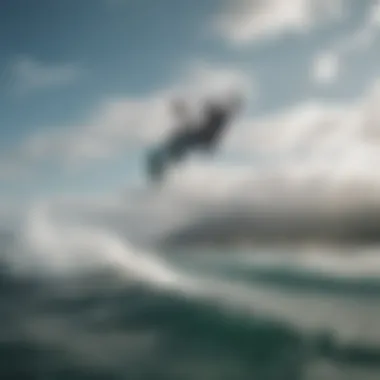

Grasping the techniques behind carving is like learning to dance with the wind. It is not merely about moving from point A to point B; it’s about the rhythm, flow, and finesse that turn an ordinary kiteboarding session into an extraordinary experience. Mastering carving not only adds excitement to your rides but also greatly enhances your control and performance on the water, making every turn smooth like butter. Ultimately, it's about creating a seamless connection between the rider, the water, and the kite.
Carving Downwind vs. Upwind
When we talk about carving, one of the first things to grasp is the distinction between carving downwind and upwind. Each approach offers unique challenges and rewards.
- Carving Downwind: This technique involves moving in the same direction as the wind. The body’s position is crucial here; keeping your weight back and low helps maintain speed. Additionally, adjusting your kite's angle enables efficient power transfer. Riders can generate immense speed while carving, leading to exhilarating experiences. Think of it like rolling downhill—momentum helps you glide effortlessly.
- Carving Upwind: It’s a different ball game. Here, you fight against the wind while still maintaining a controlled carve. This demands a keen understanding of angle and balance; if executed correctly, you glide forward while partially resisting the wind’s push. Riders need to focus on shifting their weight forward and using their edges effectively. Imagine slicing through the water with precision, making each carve a statement of skill and control.
Both styles require practice to perfect, and each bring out different elements of a rider’s skill set. Understanding the nuances among these techniques aids in preparing for various challenges on the water.
Dynamic Carving: Strategies to Enhance Performance
Dynamic carving is where technique meets artistry. This is the advanced level of carving that many aspire to. It’s about executing sharp turns, maximizing speed, and enhancing fluidity. Here are pivotal strategies to elevate dynamic carving:
- Loading the Edge: Engage the board's edges before a carve. By leaning into your cuts and distributing your weight strategically, you can create more grip and thus recover better from sharp turns.
- Control Kite Position: Having your kite in an optimal position is crucial for maintaining speed and control. Keep the kite slightly higher during carving to harness more power, allowing you to slice through the water at impressive angles.
- Timing Your Turns: The timing of a turn is everything. Too early, and you might lose momentum; too late, and you risk losing your balance. Practicing your turn timing can help you find that sweet spot, making your carving feel intuitive rather than forced.
- Practice Sliding: Engage in sliding turns, where you allow the board to glide sideways during the carve. This not only looks stylish but also builds a strong sense of control and confidence in your board management.
- Focus on Breath: Sounds odd, but controlling your breath can influence your balance and mindset during every carve. Breathe steadily and allow yourself to feel in rhythm with the water.
With these practiced techniques in mind, kiteboarding becomes not just a sport but an elegant conversation with nature. Mastering dynamic carving paves the way for advanced skills, showcasing how artistry and athleticism coexist in every adventure on the waves.
Common Mistakes and How to Avoid Them
Mistakes are part of the learning curve, especially in a sport like kiteboarding where control and precision are paramount. The key is recognizing those pitfalls and sidestepping them to enhance your experience on the water. By diving into common mistakes associated with carving, we’ll uncover essential insights that could make or break your ride. Steering clear of these blunders not only keeps your performance sharp but also maximizes your enjoyment, allowing you to fully embrace the thrill of carving.
Over-rotation and Balance Issues
One notable mistake that many kiteboarders encounter is over-rotation during their carving maneuvers. This occurs when a rider spins more than intended, often leading to a loss of control and a tumble into the water.
To combat this, it’s crucial to maintain a balanced body position. Keeping your center of gravity low, aligning your body with the board, can significantly mitigate the risk of over-rotation. Remember, your body is your biggest tool in carving. When preparing for a turn, focus on rotational mechanics.
- Tips for Correcting Over-rotation:
- Practice slow turns: Start by making gradual turns to get a feel for the board’s response and balance.
- Use your arms strategically: Reach out with your arms for balance as you carve. This can help in maintaining a stable position.
- Visualize the turn: Before executing a turn, mentally visualize the angle you aim for. When your mind is set, your body will follow suit more naturally, reducing erratic movements.
Staying grounded and being conscious of your weight distribution is key. In the heat of the moment, it can be easy to get carried away; thus, practicing mindful carving with patience can go a long way.
Underestimating Wind Conditions
Another blunder often seen among riders is underestimating wind conditions. Kiteboarding is heavily reliant on wind; misjudging its speed or direction can lead to a nasty surprise. Harnessing the wind effectively is about more than just power; it’s about understanding how wind interacts with your movements.
When carving, it’s essential to adjust your technique based on current wind conditions. Here are a few strategies:
- Check the wind forecast: Before heading out, always consult reliable sources for wind forecasts. Even slight variations can significantly affect performance.
- Test the water: Take a few test runs to gauge the wind strength and how it’s affecting your board and kite. This can inform your approach before you dive into more complex maneuvers.
- Adapt your carving style: Windy conditions may require you to carve more aggressively or adjust your board’s angle to optimize lift.
Understanding and respecting wind conditions can save you from unnecessary mishaps and elevate your kiteboarding experience.
By avoiding over-rotation and taking wind conditions into account, riders not only enhance their carving skills but also significantly reduce the risk of accidents. Adopting these strategies leads to a more enjoyable ride and helps cultivate a deeper connection with the sport.
Best Locations for Carving Experience
Finding the right spots to practice carving in kiteboarding is crucial for both skill development and enjoyment. Locations impact not just the performance of riders but also their safety and overall experience with the sport. When choosing the ideal location, factors such as wind conditions, water quality, and the surrounding environment come into play.
These spots can provide kiteboarders with varying degrees of challenge depending on their skill level and preferred riding style. Selecting a destination that aligns with an individual's carving preferences can greatly enhance one’s progress and confidence on the water.
Top Kiteboarding Spots Around the World
- Cape Town, South Africa
Known for its consistent winds, Cape Town is a mecca for kiteboarders. The famous Bloubergstrand beach offers flat water and incredible wave riding. The strong cross-shore winds here create ideal conditions for carving, making it a favorite among advanced riders. - Tarifa, Spain
Often referred to as the wind capital of Europe, Tarifa boasts both summer and winter winds. The area offers a mix of flat water lagoons and wave spots, giving riders a diverse setting for carving practice. On windy days, it's not uncommon to see dozens of kiteboarders carving their way across the water, showcasing an exhilarating spectacle. - Hood River, Oregon, USA
The Columbia River Gorge creates a unique wind tunnel effect, producing reliable winds that are perfect for carving. With a range of spots catering to different skills and styles, Hood River is a top choice for both beginners and pros looking to refine their carving techniques. - Maui, Hawaii
Known for its stunning scenery and great wind conditions, Maui offers various spots such as Kanaha Beach where riders can practice carving among waves. The warm water and beautiful backdrop make it an attractive location for kiteboarding enthusiasts. - Boracay Island, Philippines
For those seeking the perfect combination of beauty and performance, Boracay is hard to beat. The kiteboarding spots feature crystal-clear waters and consistent winds ideal for beginner to intermediate riders focusing on carving. The vibrant atmosphere and pristine beaches make it an alluring choice.
Hidden Gems for Advanced Riders
For experienced riders seeking less crowded options with challenging conditions, some hidden gems offer great opportunities to hone carving techniques:
- La Ventana, Mexico
This lesser-known spot is a favorite among those wanting a more tranquil kiteboarding experience. La Ventana offers steady winds and large bays that can provide perfect flat water for maneuvering and carving. - Cumbuco, Brazil
While Cumbuco isn’t completely off the beaten path, it's a spot where advanced riders can challenge themselves. The downwind runs and diverse conditions create opportunities for perfecting elegant carving, particularly in the afternoons when the winds pick up. - Sicily, Italy
Known for its breathtaking landscapes, some lesser-known beaches in Sicily provide ideal carving conditions. The southeast coast, in particular, is best known for its steady winds during summer months, offering pristine conditions for advanced riders to test their skills. - Langebaan, South Africa
A little farther away from Cape Town, Langebaan serves up flat water lagoons that create excellent carving conditions. The spot is quieter compared to its more famous neighbor, allowing riders more space to practice without the hustle of busy beaches.
Each of these locations presents unique opportunities and challenges for kiteboarders. By understanding the characteristics of various spots, riders can effectively improve their carving techniques, enabling them to ride with more confidence and flair.
Safety Measures While Carving
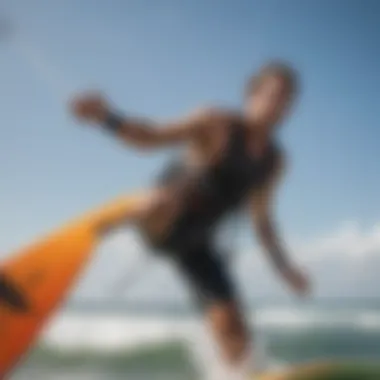

Carving can elevate the experience of kiteboarding from merely enjoyable to incredibly exhilarating. However, this thrill comes with its own set of risks. Practicing safety measures while carving isn't just a guideline; it's a necessity, ensuring both your own well-being and that of fellow kiteboarders. This section explores crucial safety elements that kiteboarders should prioritize to maximize fun while minimizing hazards.
Understanding Kite Safety Signals
Understanding kite safety signals is fundamental for effective communication on the water. Signals help kiteboarders convey their intentions, which can be a game changer, especially in crowded spots where potential conflicts might arise.
Here are some key signals to grasp:
- Raise your kite above your head: This signal typically indicates that a rider is about to launch their kite or is in a stable position and ready to ride.
- One hand raised with a fist: This is a common signal that warns others of an impending issue, like a crash or equipment failure.
- Waving both arms: This indicates distress, whether it’s a gear problem or a need for assistance.
Familiarizing yourself with these signals allows you to communicate effectively, providing everyone on the water a chance to react appropriately.
Environmental Awareness and Impact
Kiteboarding, while thrilling, can take a toll on the environment if proper precautions aren’t taken. Environmental awareness involves considering how your actions during carving can affect marine life and local ecosystems.
Points to consider:
- Choose appropriate locations: Some areas are designated for water sports, while others are sensitive ecosystems. Opt for spots that minimize environmental disruption.
- Respect wildlife: When carving, keep an eye out for wildlife. Disturbing their habitats can lead to unintended consequences.
- Leave no trace: After your session, make sure to clean up your area. This simple act contributes greatly to protecting nature.
- Use eco-friendly gear: Some manufacturers provide sustainable options that reduce your environmental footprint. When selecting gear, look for items made from environmentally friendly materials.
Finale
Implementing safety measures while carving allows you to enjoy your kiteboarding sessions while staying safe. Understanding kite safety signals helps streamline communication, while fostering environmental awareness leads to a more sustainable practice. Together, these elements create not just safer conditions, but also enrich the overall kiteboarding experience, allowing enthusiasts to enjoy their passion responsibly. As you refine your carving techniques, remember that the ultimate goal is not just to shred the waves but to do so safely and considerately.
The Future of Carving in Kiteboarding
As kiteboarding continues to catch on with enthusiasts around the globe, the future of carving within the sport looks brighter than ever. This section delves into crucial advancements in gear technology and evolving techniques that promise to reshape the art of carving. By understanding these developments, riders can better equip themselves to enhance their skills, push boundaries, and connect with the ever-growing kiteboarding community. The relevance lies in the fact that as the landscape of the sport shifts, so too must the approaches to carving, ensuring riders remain at the forefront of innovation and safety.
Innovations in Gear Technology
The kiteboarding industry is in a constant state of evolution, especially concerning gear technology. Modern advancements are making it easier for riders at all levels to engage in carving maneuvers. One notable change comes in the form of kites designed with higher aspect ratios. These kites offer improved lift and stability, allowing for more controlled carving.
- Material Upgrades: New fabric blends are lighter and more durable, reducing drag, which is vital when making those sharp turns.
- Board Designs: Innovations in shapes and construction, such as rocker profiles, allow for quicker transitions and more fluid movements. Riders can switch opinions mid-carve without losing momentum.
- Smart Technology: Some manufacturers are incorporating sensors and connectivity into gear. This tech provides real-time feedback about performance metrics, which would be incredibly useful for coaching and improving carving techniques.
Where kiteboarding once required a hefty investment in gear to truly master carving, advancements now give riders more bang for their buck. As gear becomes more accessible, there's an increasing number of riders able to partake in this exhilarating facet of kiteboarding. Riders can also expect enhanced comfort, making carving sessions longer and more enjoyable.
Evolution of Techniques and Styles
Techniques in kiteboarding are not set in stone; they are ever-changing, molded by riders' creativity and advancements in gear. The evolution of carving techniques often mirrors the culture and style of the riders themselves.
- Hybrids and Unconventional Styles: With the creativity of riders merging disciplines, we now see elements from surfing and snowboarding being integrated into kiteboarding. This crossover is leading to more dynamic moves that would have seemed impossible just a few years ago.
- Increased Focus on Aerodynamics: Riders are becoming increasingly aware of their body's placement and how it affects airflow around them. This understanding enables them to refine their techniques to minimize drag and improve their carving efficiency.
- Community Participation: Social media platforms and forums like Reddit have spurred a wave of sharing techniques. Kiteboarders from all over the world discuss their styles, tricks, and best practices, leading to an exchange of knowledge that accelerates the learning curve for many.
With these evolving techniques and styles, riders can take carving to new heights, making it not only an essential part of kiteboarding but an expression of personal style. As kiteboarding communities grow, so too will the opportunities to master these techniques and push the limits of what can be achieved while carving the waves.
*"The future is bright for those riding the wind; the only limit is creativity and skill."
In summary, the ongoing innovations in gear technology combined with the evolution of techniques ensure that carving will remain a pivotal aspect of kiteboarding. It's a thrilling time for riders, as advancements make it easier to navigate the waves and express individuality on the water.
Connecting with the Kiteboarding Community
In the world of kiteboarding, connecting with others who share your passion isn’t just a nice addition; it’s an essential part of the journey. The kiteboarding community act as a lifeline, offering a shared sense of belonging and a wealth of knowledge that can significantly enhance both your skills and enjoyment of the sport. Engaging with fellow enthusiasts can lead to valuable insights about carving techniques, gear recommendations, and the latest advancements in the sport.
Building relationships within this vibrant community can provide motivation, inspiration, and a platform for sharing your experiences and learning from others. Whether you are a novice seeking guidance or an experienced rider looking to hone your craft, connections can bring fresh perspectives and encouragement.
Sharing Experiences and Knowledge
The act of sharing is fundamental to the kiteboarding community. Whether through online forums, local meet-ups, or social media platforms like Facebook and Reddit, riders can exchange stories that illuminate their carving experiences. This exchange not only enriches your own understanding but also helps others to grow and learn.
Common themes that often arise in these discussions include:
- Technique Exploration: Often, riders will delve into specific nuances of carving techniques, discussing what works and what doesn't based on personal experiences.
- Gear Insights: The collective wisdom can reveal which kiteboards are preferred for carving and why, guiding others in making informed gear choices.
- Location Recommendations: Through word of mouth, riders often uncover hidden gems or unexpected spots suitable for carving.
Being active in discussions fosters a spirit of learning. Readers can post questions or share doubts, and the community is usually quick in rallying to help out. It's like having a network of coaches and buddies all rolled into one.
Participating in Competitions and Events
Involvement in competitions and kiteboarding events shapes not just personal abilities but the community at large. These gatherings serve as an excellent platform for testing one’s skills, meeting fellow kiteboarding aficionados, and immersing in the thrill of the sport. Competitions can also provide motivation—pushing riders to improve their carving techniques and overall performance. Besides the thrill of competition, these events bring a sense of camaraderie.
Key aspects of engaging in kiteboarding competitions include:
- Skill Development: Participating in events can drive riders to refine their technique under pressure.
- Networking Opportunities: You can meet seasoned professionals and hobbyists alike, opening doors to friendships and mentorship.
- Fun and Fellowship: The atmosphere is often electrifying. Participants can cheer each other on, creating bonds that transcend competition.












